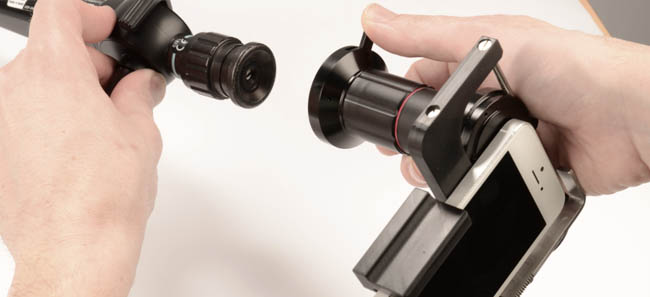
Extending the scope of smart phones
Staff
General DPNSymbiosis is a word that properly belongs in the lexicon of biology. It refers to the cooperative, mutually beneficial relationship between two organisms – but it’s meaning is especially apt when it describes a smartphone and an endoscope.
An endoscope (scope for short) is an instrument that enables a doctor to look inside a patient – it predates a smart phone by a couple of hundred years. In its primary function, an endoscope is used as a diagnostic (endoscopy) instrument to determine an effective therapy, namely whether surgery or a more conservative method should be applied (this is especially true in the early stages of cancer).
The first known endoscope for internal inspection was designed in 1805 by a German doctor who was attempting to examine the urinary tract but not until 1868 was an endoscope used to explore inside the stomach of a living person.
The earliest endoscopes were rigid and whatever could be seen through them was probably neither treatable nor, at the time, understood. The process of looking probably did more to satisfy the doctor’s curiosity than contribute to the well being of the patient for whom the experience must have been fraught with excruciating pain.
The array of endoscopes for modern medicine is now vast and specific to almost every part of the body. Scopes generally have a long, thin flexible tube that the doctor can weave through a body passageway or opening through which to see inside an organ. The first flexible scopes were introduced in the 1930s and about twenty years later the gastro-camera was invented. Harold Hopkins (a renowned British physicist) played a central role in the creation of a device called a “fibroscope.” It consisted of a bundle of flexible glass fibres that, due to a more concentrated focus on the inspected areas, offered better image quality than its predecessors.
The first flexible scopes were introduced in the 1930s and about twenty years later the gastro-camera was invented. Harold Hopkins (a renowned British physicist) played a central role in the creation of a device called a “fibroscope.” It consisted of a bundle of flexible glass fibres that, due to a more concentrated focus on the inspected areas, offered better image quality than its predecessors.
Today, with the combination of innovation and technology, the bar has been raised again on medical science by advancing the efficacy of endoscopy.
Clearwater Clinical develops mobile medical solutions that target the endoscopy and audiology markets. Its mission is to accelerate and democratize access to medical solutions by delivering rapid deployment at a fraction of the cost of traditional approaches.
In 2013, Clearwater introduced the ClearSCOPE endoscope adaptor.
ClearSCOPE enables full high definition video recording with any smart phone attached to a generic endoscope interface. Following 14 months of field testing by more than 2000 doctors, Clearwater Clinical has now announced the general release of its ground breaking ClearSCOPE Endoscope Adaptor for smartphones.
“By taking advantage of the power of smartphones, we’ve been able to produce a video capture solution at a fraction of the cost of traditional towers,” said Dr. Matthew Bromwich, Otolaryngologist and Co-founder of Clearwater Clinical.
Today, capturing an image or a video during an endoscopic procedure requires a very expensive video tower. Video towers – aside from being very expensive – are large and cumbersome and have to be pushed between locations on carts. Due to their cost, hospitals don’t usually have more than one or two video towers, often only available during surgery.
If a doctor or medical intern doesn’t have access to a tower, images can’t be captured during a procedure and this often means that a patient will need to be re-scoped later by a specialist. This frequent duplication of effort doubles the patient discomfort that, while a mere inconvenience to adults, makes the procedure twice as traumatic to children.
Endoscopy and smartphones also pair well for the future of remote medicine since many small clinics may never be able to afford an expensive video tower yet still need to consult with specialists in cities – maybe even countries – far away.
In addition to the manifold benefits to the diagnostic process, the extent to which ClearSCOPE can graphically capture a procedure has powerful educational value for students and residents.
All these are the benefits that propelled the creation of the ClearSCOPE endoscope adaptor. Everyone has the power of HD video imaging in their pockets so by creating an adaptor that connects a smartphone to any standard endoscope, doctors and residents can now have easy and affordable access to HD video and still images for every procedure performed.
ClearSCOPE’s unique design is brought to reality by L-D Tool & Die of Stittsville, ON (recently certified ISO 13485 Medical Manufacturing), so the combination of a valuable product with quality manufacturing again exemplifies “a symbiosis.”
Mark Sunderland is president of Ottawa-based Biomedical Industry Group.
